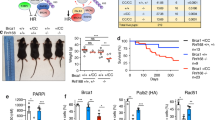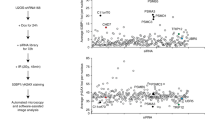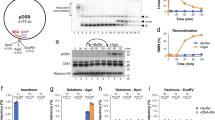Abstract
The formation of γ-H2AX foci after DNA double strand breaks (DSBs) is crucial for the cellular response to this lethal DNA damage. We previously have shown that BRG1, a chromatin remodeling enzyme, facilitates DSB repair by stimulating γ-H2AX formation, and this function of BRG1 requires the binding of BRGI to acetylated histone H3 on γ-H2AX-containing nucleosomes using its bromodomain (BRD), a protein module that specifically recognizes acetyl-Lys moieties. We also have shown that the BRD of BRG1, when ectopically expressed in cells, functions as a dominant negative inhibitor of the BRG1 activity to stimulate γ-H2AX and DSB repair. Here, we found that BRDs from a select group of proteins have no such activity, suggesting that the γ-H2AX inhibition activity of BRG1 BRD is specific. This finding led us to search for more BRDs that exhibit γ-H2AX inhibition activity in the hope of finding additional BRD-containing proteins involved in DNA damage responses. We screened a total of 52 individual BRDs present in 38 human BRD-containing proteins, comprising 93% of all human BRDs. We identified the BRD of cat eye syndrome chromosome region candidate 2 (Cecr2), which recently was shown to form a novel chromatin remodeling complex with unknown cellular functions, as having a strong γ-H2AX inhibition activity. This activity of Cecr2 BRD is specific because it depends on the chromatin binding affinity of Cecr2 BRD. Small interfering RNA knockdown experiments showed that Cecr2 is important for γ-H2AX formation and DSB repair. Therefore, our genomewide screen identifies Cecr2 as a novel DNA damage response protein.
Similar content being viewed by others
References
Banting, G.S., Barak, O., Ames, T.M., Burnham, A.C., Kardel, M.D., Cooch, N.S., Davidson, C.E., Godbout, R., McDermid, H.E., and Shiekhattar, R. (2005). CECR2, a protein involved in neurulation, forms a novel chromatin remodeling complex with SNF2L. Hum. Mol. Genet. 14, 513–524.
Bao, Y., and Shen, X. (2007). Chromatin remodeling in DNA double-strand break repair. Curr. Opin. Genet. Dev. 17, 126–131.
Bienz, M. (2006). The PHD finger, a nuclear protein-interaction domain. Trends Biochem. Sci. 31, 35–40.
Bonner, W.M., Redon, C.E., Dickey, J.S., Nakamura, A.J., Sedelnikova, O.A., Solier, S., and Pommier, Y. (2008). GammaH2AX and cancer. Nat. Rev. Cancer 8, 957–967.
Chao, C., Wu, Z., Mazur, S.J., Borges, H., Rossi, M., Lin, T., Wang, J.Y., Anderson, C.W., Appella, E., and Xu, Y. (2006). Acetylation of mouse p53 at lysine 317 negatively regulates p53 apoptotic activities after DNA damage. Mol. Cell. Biol. 26, 6859–6869.
Ciccia, A., and Elledge, S.J. (2010). The DNA damage response: making it safe to play with knives. Mol. Cell 40, 179–204.
Das, C., Lucia, M.S., Hansen, K.C., and Tyler, J.K. (2009). CBP/p300-mediated acetylation of histone H3 on lysine 56. Nature 459, 113–117.
Dawe, C.E., Kooistra, M.K., Fairbridge, N.A., Pisio, A.C., and Mc-Dermid, H.E. (2011). Role of chromatin remodeling gene Cecr2 in neurulation and inner ear development. Dev. Dyn. 240, 372–383.
Fairbridge, N.A., Dawe, C.E., Niri, F.H., Kooistra, M.K., King-Jones, K., and McDermid, H.E. (2010). Cecr2 mutations causing exencephaly trigger misregulation of mesenchymal/ectodermal transcription factors. Birth Defects Res. A Clin. Mol. Teratol. 88, 619–625.
Footz, T.K., Brinkman-Mills, P., Banting, G.S., Maier, S.A., Riazi, M.A., Bridgland, L., Hu, S., Birren, B., Minoshima, S., Shimizu, N., et al. (2001). Analysis of the cat eye syndrome critical region in humans and the region of conserved synteny in mice: a search for candidate genes at or near the human chromosome 22 pericentromere. Genome Res. 11, 1053–1070.
Huyen, Y., Zgheib, O., Ditullio, R.A., Jr., Gorgoulis, V.G., Zacharatos, P., Petty, T.J., Sheston, E.A., Mellert, H.S., Stavridi, E.S., and Halazonetis, T.D. (2004). Methylated lysine 79 of histone H3 targets 53BP1 to DNA double-strand breaks. Nature 432, 406–411.
Jackson, S.P., and Bartek, J. (2009). The DNA-damage response in human biology and disease. Nature 461, 1071–1078.
Lee, H.S., Park, J.H., Kim, S.J., Kwon, S.J., and Kwon, J. (2010). A cooperative activation loop among SWI/SNF, gamma-H2AX and H3 acetylation for DNA double-strand break repair. EMBO J. 29, 1434–1445.
Lukas, J., Lukas, C., and Bartek, J. (2011). More than just a focus: The chromatin response to DNA damage and its role in genome integrity maintenance. Nat. Cell Biol. 13, 1161–1169.
Martin, C., and Zhang, Y. (2005). The diverse functions of histone lysine methylation. Nat. Rev. Mol. Cell Biol. 6, 838–849.
Mujtaba, S., Zeng, L., and Zhou, M.M. (2007). Structure and acetyllysine recognition of the bromodomain. Oncogene 26, 5521–5527.
Park, J.H., Park, E.J., Lee, H.S., Kim, S.J., Hur, S.K., Imbalzano, A.N., and Kwon, J. (2006). Mammalian SWI/SNF complexes facilitate DNA double-strand break repair by promoting gamma-H2AX induction. EMBO J. 25, 3986–3997.
Park, J.H., Park, E.J., Hur, S.K., Kim, S., and Kwon, J. (2009). Mammalian SWI/SNF chromatin remodeling complexes are required to prevent apoptosis after DNA damage. DNA Repair (Amst) 8, 29–39.
Sanchez, R., and Zhou, M.M. (2009). The role of human bromodomains in chromatin biology and gene transcription. Curr. Opin. Drug Discov. Devel. 12, 659–665.
Shen, W., Xu, C., Huang, W., Zhang, J., Carlson, J.E., Tu, X., Wu, J., and Shi, Y. (2007). Solution structure of human Brg1 bromodomain and its specific binding to acetylated histone tails. Biochemistry 46, 2100–2110.
Singh, M., Popowicz, G.M., Krajewski, M., and Holak, T.A. (2007). Structural ramification for acetyl-lysine recognition by the bromodomain of human BRG1 protein, a central ATPase of the SWI/SNF remodeling complex. Chembiochem 8, 1308–1316.
Taverna, S.D., Li, H., Ruthenburg, A.J., Allis, C.D., and Patel, D.J. (2007). How chromatin-binding modules interpret histone modifications: lessons from professional pocket pickers. Nat. Struct. Mol. Biol. 14, 1025–1040.
Thompson, P.J., Norton, K.A., Niri, F.H., Dawe, C.E., and McDermid, H.E. (2012). CECR2 is involved in spermatogenesis and forms a complex with SNF2H in the testis. J. Mol. Biol. 415, 793–806.
Tjeertes, J.V., Miller, K.M., and Jackson, S.P. (2009). Screen for DNA-damage-responsive histone modifications identifies H3K9Ac and H3K56Ac in human cells. EMBO J. 28, 1878–1889.
van Attikum, H., and Gasser, S.M. (2009). Crosstalk between histone modifications during the DNA damage response. Trends Cell Biol. 19, 207–217.
Zhang, Q., Chakravarty, S., Ghersi, D., Zeng, L., Plotnikov, A.N., Sanchez, R., and Zhou, M.M. (2010). Biochemical profiling of histone binding selectivity of the yeast bromodomain family. PLoS One 5, e8903.
Author information
Authors and Affiliations
Corresponding author
Additional information
These authors contributed equally to this work.
About this article
Cite this article
Lee, SK., Park, EJ., Lee, HS. et al. Genome-wide screen of human bromodomain-containing proteins identifies Cecr2 as a novel DNA damage response protein. Mol Cells 34, 85–91 (2012). https://doi.org/10.1007/s10059-012-0112-4
Received:
Accepted:
Published:
Issue Date:
DOI: https://doi.org/10.1007/s10059-012-0112-4




